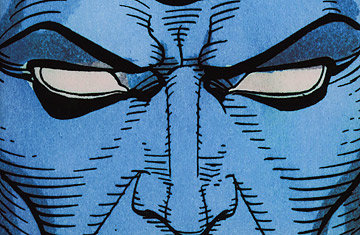
Dave Gibbons' Watching the Watchmen.
Dave Gibbons comes across like a pretty regular English bloke, apart from his manic verbal energy and his aesthetically advanced glasses. But he is, in fact, a genius — one of the major comic book artists of the 21st century, or the 20th, or really any other century you care to name. Along with writer Alan Moore, he is one half of the team that in 1986 created the seminal Watchmen, a graphic novel so painstakingly crafted and darkly radical that its publication changed the superhero genre forever. If you're wondering where The Dark Knight got its darkness, look no further. Zack Snyder, director of 300, recently wrapped a movie adaptation of Watchmen, and this month Titan Books is publishing a new book by Gibbons called Watching the Watchmen, a gorgeous, oversized graphical history of how Watchmen came to be. TIME's book critic Lev Grossman sat down with Gibbons to talk about it.
So how did you get into drawing comics in the first place?
I vividly remember my first Superman comic, which my granddad bought me when I was about 7. From that point on, all I wanted to do is draw comics. And specifically, superhero and science fiction comics. Basically I used to copy comic books, and draw my own comics on scrap paper. But I had an education which was rather hostile to that, because I was quite clever at school, and I could do other things like physics and chemistry and stuff, and so I got kind of sidetracked.
I came to think that nobody from England could draw American comic books, because they were clearly all done by this sort of Mafia, all these guys with Italian and Irish names who had the whole thing sewn up. It was actually seeing a comic book drawn by Barry Smith, who was about my age, and English. He'd done it, so I clearly remember thinking: it can be done. And once it became a possiblity that was all I pursued. I was probably about 19 or 20. That was it.
Some of the notes from Alan to you, reprinted in Watching the Watchmen, are very warm and funny.
And what you can't see in that book, because there is no record of it, is that we would talk on the phone for hours. We'd be on the phone for three, four hours. It was just like long conversations between friends with common interests, and somehow enough came out of it to actually make it into a comic book.
I was thinking about this. We didn't ever set out to say, all right, you know what we're going to do? We're going to do the best f------g comic book that's ever been done. This is going to be the Citizen Kane of comics. We are going to be famous for this for the next two and a half decades. If we'd done that we would have come up with nothing.
Another thing that comes across in the book is the sheer physical mechanics of producing comics back in the 1980's, before everything became computerized—literally painting in the colors, noting the codes for the different dyes on the page...
It was primitive! The actual color separations were done at home by ladies working in their kitchens! Really basic. It had been unchanged since the 1930s. And of course, we didn't even have fax machines. So Alan would have to physically send the script to me. When I started to run low on script, to keep me busy, he put the scripts in a taxi and paid $100 to get the script to me. Nowadays, script's done, send. Art's done, send.
See pictures of cover art by Watching the Watchmen book jacket designer Chip Kidd.
